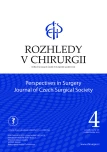Cryptogenic hepatocellular carcinoma as a cause of hemoperitoneum – a case report
Authors:
T. Voborník
Authors‘ workplace:
Chirurgické oddělení, Oblastní nemocnice Mladá Boleslav
Published in:
Rozhl. Chir., 2022, roč. 101, č. 4, s. 180-183.
Category:
Case Report
doi:
https://doi.org/10.33699/PIS.2022.101.4.180–183
Overview
Introduction: Cryptogenic hepatocellular carcinoma (HCC) is a malignant liver tumor that develops in patients without liver cirrhosis. HCC bleeding in the abdominal cavity is a life threatening event.
Case report: We present the case of a 73-year-old man with unconsciousness and hemoperitoneum on computed tomography (CT). The hemoperitoneum was caused by a bleeding liver tumor which was found during acute laparotomy. Perihepatic packing was performed. Despite all intensive care, the patient died.
Conclusion: Bleeding from/to hepatocellular carcinoma is a severe event with high lethality. Laparotomy to stop the bleeding is the method of choice in hemodynamically unstable patients. Other treatment options can be used in stable patients.
Keywords:
cryptogenic hepatocellular carcinoma
Sources
1. Nuño-Guzmán CM, Marín-Contreras ME. Ruptured hepatocellular carcinoma and non-alcoholic fatty liver disease, a potentially life-threatening complication in a population at increased risk. Ann Hepatol. 2020 Jan-Feb;19(1):3−4. doi: 10.1016/j.aohep.2019.11.001. PMID: 31916949.
2. Klvaňa P, Olbrechtová M, Loveček M, et al. Nezvyklá manifestace časného kryptogenního hepatocelulárního karcinomu. Gastroenterologie a hepatologie 2016;70(4):331−334. doi: 10.14735/ amgh2016csgh.info08.
3. Al-Fraij AK, Dhar PM, Al-Khalejy A, et al. Massive hemorrhage from spontaneous ruptured hepatocellular carcinoma controlled by isoamyl 2-cyanoacrylate: a case report. Med Princ Pract. 2011;20(3):297−299. doi: 10.1159/000323833. Epub 2011 Mar 29. PMID: 21455005.
4. Bassi N, Caratozzolo E, Bonariol L, et al. Management of ruptured hepatocellular carcinoma: implications for therapy. World J Gastroenterol. 2010 Mar 14;16(10):1221−1225. doi: 10.3748/wjg. v16.i10.1221. PMID: 20222165; PMCID: PMC2839174.
5. Yoshida H, Mamada Y, Taniai N, et al. Spontaneous ruptured hepatocellular carcinoma. Hepatol Res. 2016 Jan;46(1):13−21. doi: 10.1111/hepr.12498. Epub 2015 Mar 2. PMID: 25631290.
6. Darnis B, Rode A, Mohkam K, et al. Management of bleeding liver tumors. J Visc Surg. 2014 Oct;151(5):365−375. doi: 10.1016/j.jviscsurg.2014.05.007. Epub 2014 Jun 18. PMID: 24950941.
7. Ferda J, Ferdová E, Mírka H, et al. Hepatocelulární karcinom - zobrazovací metody a intervence pod kontrolou zobrazovacích metod. Klinická onkologie 2020;33,Suppl. 3:5−12. ISSN: 0862-495X; 1802-5307 (electronic version). doi: 0.14735/amko20203S5.
8. Třeška V. Chirurgická léčba hepatocelulárního karcinomu. Klinická onkologie 2020;33,Suppl. 3:30−33. ISSN: 0862-495X; 1802-5307. doi: 0.14735/amko20203S30.
Labels
Surgery Orthopaedics Trauma surgeryArticle was published in
Perspectives in Surgery

2022 Issue 4
Most read in this issue
- Our technique of thoracoscopic first rib resection – case report
- Achalasia – position of surgery in current management
- Potential use of mesenchymal stem cells in the treatment of inflammatory bowel disease – a systematic review of the literature
- 30 let miniinvazivní chirurgie v České republice
